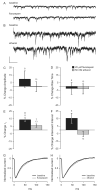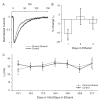The effects of acute and chronic ethanol exposure on presynaptic and postsynaptic gamma-aminobutyric acid (GABA) neurotransmission in cultured cortical and hippocampal neurons
- PMID: 20004338
- PMCID: PMC2796564
- DOI: 10.1016/j.alcohol.2009.10.006
The effects of acute and chronic ethanol exposure on presynaptic and postsynaptic gamma-aminobutyric acid (GABA) neurotransmission in cultured cortical and hippocampal neurons
Abstract
Decades after ethanol was first described as a gamma-aminobutyric acid (GABA) mimetic, the precise mechanisms that produce the acute effects of ethanol and the physiological adaptations that underlie ethanol tolerance and dependence remain unclear. Although a substantial body of evidence suggests that ethanol acts on GABAergic neurotransmission to enhance inhibition in the central nervous system, the precise mechanisms underlying the physiological effects of both acute and chronic ethanol exposure are still under investigation. We have used in vitro ethanol exposure followed by recording of miniature inhibitory postsynaptic currents (mIPSCs) to determine whether acute or chronic ethanol exposure directly alters synaptic GABA(A) receptor (GABA(A)R) function or GABA release in cultured cortical and hippocampal neurons. Acute ethanol exposure slightly increased the duration of mIPSCs in hippocampal neurons but did not alter mIPSC kinetics in cortical neurons. Acute ethanol exposure did not change mIPSC frequency in either hippocampal or cortical neurons. One day of chronic ethanol exposure produced a transient decrease in mIPSC duration in cortical neurons but did not alter mIPSC kinetics in hippocampal neurons. Chronic ethanol exposure did not change mIPSC frequency in either hippocampal or cortical neurons. Chronic ethanol exposure also did not produce substantial cross-tolerance to a benzodiazepine in either hippocampal or cortical neurons. The results suggest that ethanol exposure in vitro has limited effects on synaptic GABA(A)R function and action potential-independent GABA release in cultured neurons and that ethanol exposure in cultured cortical and hippocampal neurons may not reproduce all the effects that occur in vivo and in acute brain slices.
Figures






Similar articles
-
Binge ethanol exposure delays development of GABAergic miniature postsynaptic currents in septal neurons.Brain Res Dev Brain Res. 2004 Sep 17;152(2):199-212. doi: 10.1016/j.devbrainres.2004.06.017. Brain Res Dev Brain Res. 2004. PMID: 15351508
-
Ethanol dual modulatory actions on spontaneous postsynaptic currents in spinal motoneurons.J Neurophysiol. 2003 Feb;89(2):806-13. doi: 10.1152/jn.00614.2002. J Neurophysiol. 2003. PMID: 12574458
-
Role of interleukin-10 (IL-10) in regulation of GABAergic transmission and acute response to ethanol.Neuropharmacology. 2016 Aug;107:181-188. doi: 10.1016/j.neuropharm.2016.03.027. Epub 2016 Mar 22. Neuropharmacology. 2016. PMID: 27016017 Free PMC article.
-
The role of GABA(A) receptors in the acute and chronic effects of ethanol: a decade of progress.Psychopharmacology (Berl). 2009 Sep;205(4):529-64. doi: 10.1007/s00213-009-1562-z. Epub 2009 May 20. Psychopharmacology (Berl). 2009. PMID: 19455309 Free PMC article. Review.
-
Neurosteroids, GABAA receptors, and ethanol dependence.Psychopharmacology (Berl). 2006 Jun;186(3):267-80. doi: 10.1007/s00213-005-0126-0. Epub 2005 Sep 15. Psychopharmacology (Berl). 2006. PMID: 16163526 Review.
Cited by
-
Potentiation of Gamma Aminobutyric Acid Receptors (GABAAR) by Ethanol: How Are Inhibitory Receptors Affected?Front Cell Neurosci. 2016 May 6;10:114. doi: 10.3389/fncel.2016.00114. eCollection 2016. Front Cell Neurosci. 2016. PMID: 27199667 Free PMC article. Review.
-
Pharmacotherapy of acute alcoholic hepatitis in clinical practice.World J Gastroenterol. 2014 Mar 7;20(9):2159-67. doi: 10.3748/wjg.v20.i9.2159. World J Gastroenterol. 2014. PMID: 24605014 Free PMC article. Review.
-
Ethanol activation of protein kinase A regulates GABAA α1 receptor function and trafficking in cultured cerebral cortical neurons.J Pharmacol Exp Ther. 2013 May;345(2):317-25. doi: 10.1124/jpet.112.201954. Epub 2013 Feb 13. J Pharmacol Exp Ther. 2013. PMID: 23408117 Free PMC article.
-
Targeting prefrontal cortex GABAergic microcircuits for the treatment of alcohol use disorder.Front Synaptic Neurosci. 2022 Aug 29;14:936911. doi: 10.3389/fnsyn.2022.936911. eCollection 2022. Front Synaptic Neurosci. 2022. PMID: 36105666 Free PMC article. Review.
-
Neurochemical mechanisms of alcohol withdrawal.Handb Clin Neurol. 2014;125:133-56. doi: 10.1016/B978-0-444-62619-6.00009-4. Handb Clin Neurol. 2014. PMID: 25307573 Free PMC article. Review.
References
-
- Aguayo LG. Ethanol potentiates the GABAA-activated Cl− current in mouse hippocampal and cortical neurons. Eur. J. Pharmacol. 1990;187:127–130. - PubMed
-
- Bouron A. Modulation of spontaneous quantal release of neurotransmitters in the hippocampus. Prog. Neurobiol. 2001;63:613–635. - PubMed
-
- Cagetti E, Liang J, Spigelman I, Olsen RW. Withdrawal from chronic intermittent ethanol treatment changes subunit composition, reduces synaptic function, and decreases behavioral responses to positive allosteric modulators of GABAA receptors. Mol. Pharmacol. 2003;63:53–64. - PubMed
Publication types
MeSH terms
Substances
Grants and funding
LinkOut - more resources
Full Text Sources

